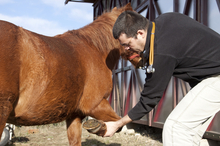Location: JONESVILLE, North Carolina
Inflammation is an important concept and plays a major role in equine health and soundness, often beginning its course as a young foal learns to stand and walk. We often tend to think about pain and swelling when we hear the term "inflammation", but in reality it goes much deeper, working on a complex cellular level.

Examining a horse for inflammation
Chronic inflammation can inflict damage on a cellular level contributing to tissue weakness, repeated injury, joint degeneration, tendon damage, allergies, sore muscles and a host of other conditions impacting the horse.
© 2012 by Artist Name
Acute inflammation is important for the body as it helps us and them to respond to bacterial/viral invaders, repair wounds and recover. During this process, there are many pro-inflammatory proteins released within the body that trigger all types of responses from recruitment of white blood cells to alterations in blood circulation.
This acute response is temporary in most cases, slowing down the response as the injury or infection is resolved.
The problem that comes is when this acute response fails to resolve and remains persistent, which means that there is a constant low level release of these pro-inflammatory proteins or cytokines.
This constant release, even at low levels, can inflict damage on a cellular level contributing to tissue weakness, repeated injury, joint degeneration, tendon damage, allergies, sore muscles and a host of other conditions impacting the horse. This is termed chronic inflammation.
There are many factors that contribute to chronic inflammation and include training, competition, diet, lifestyle factors, stress and genetics; but more than often they all tend to play a major role.
As horse owners and even veterinarians, we recognize that inflammation is a factor, but often the approach to managing it is limited. We resort to treatments including joint injections, NSAIDs and even try to repair the damage through use of stem cells and other therapies, but the truth is that the inflammatory process is only partially being controlled.
In order to better understand options to help manage and even possibly prevent certain conditions, keeping our equine athletes at their best, we need to comprehend what is going on at a cellular level. If we can apply what research has taught us, then our chances for better recoveries, soundness and performance can be improved.
For more information about our Cur-OST formulas, please visit www.curost.com. All inquiries and questions for Dr. Schell may be directed to tschelldvm@gmail.com
